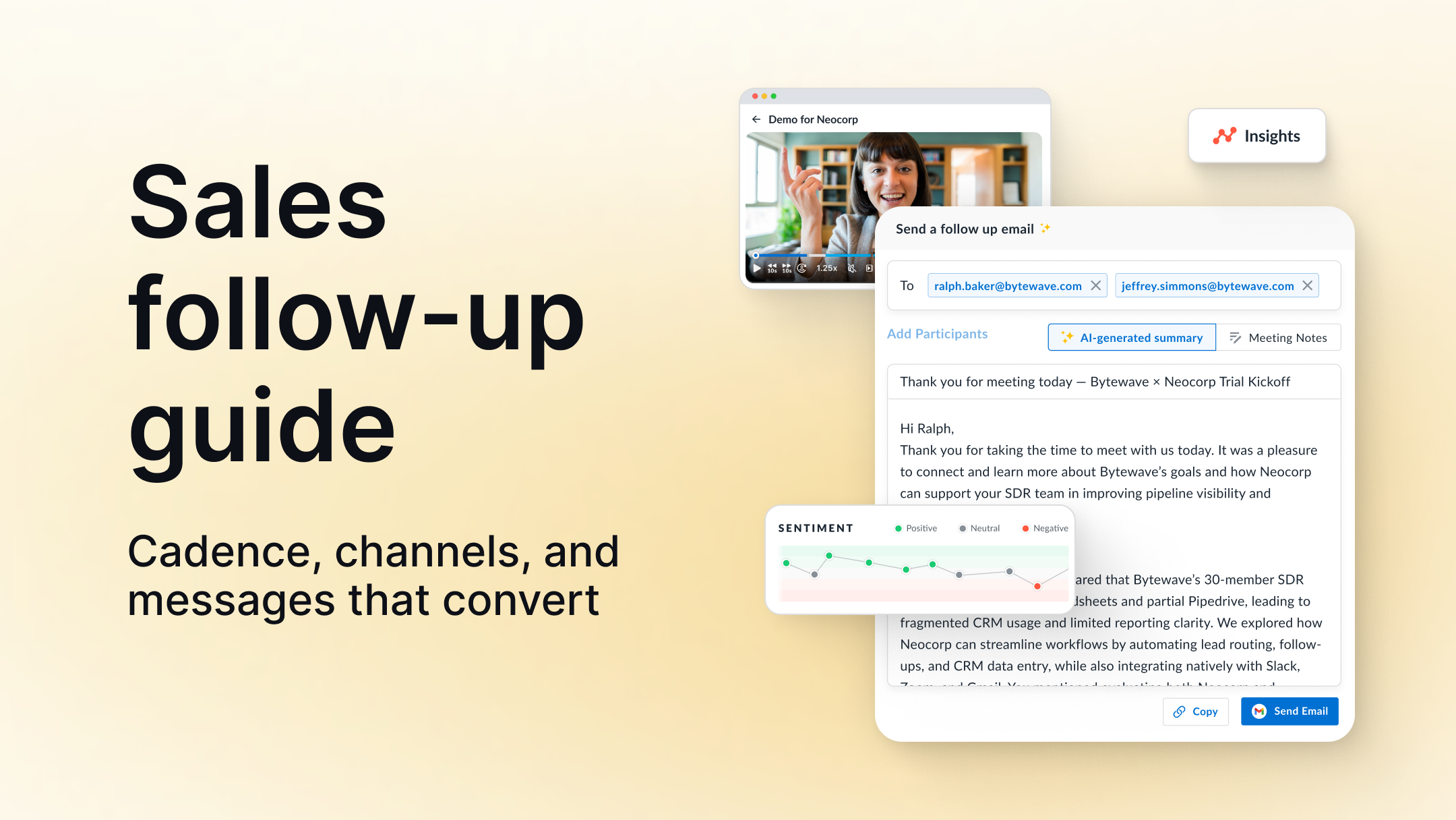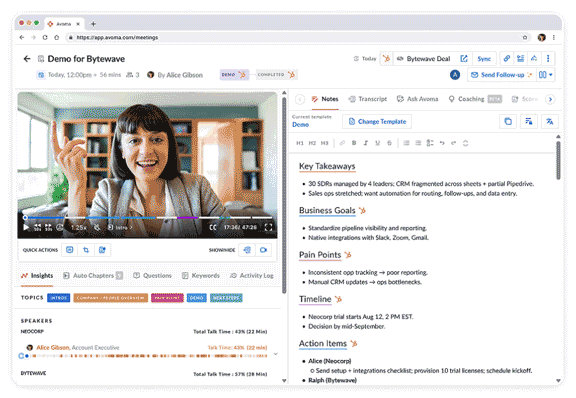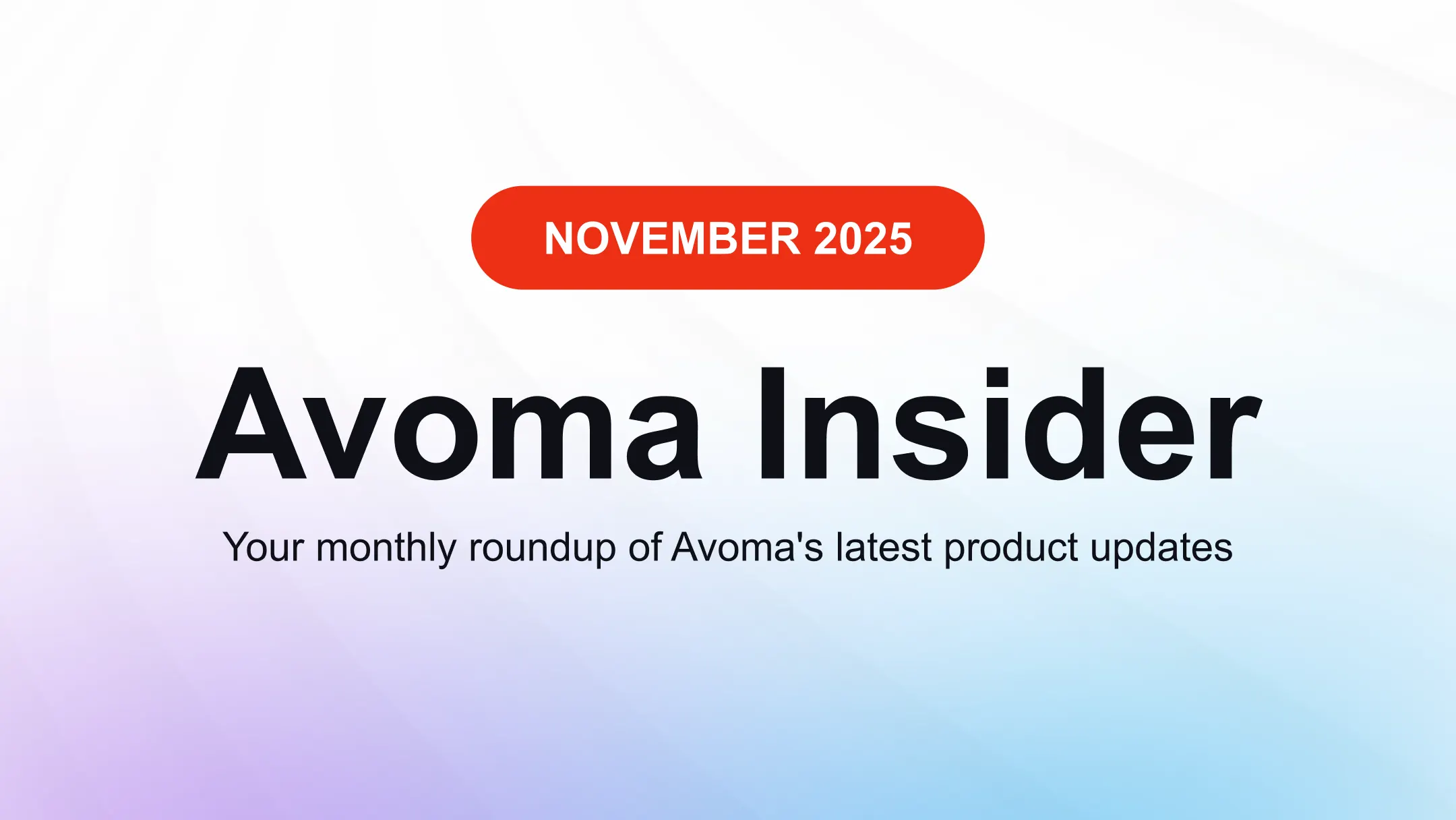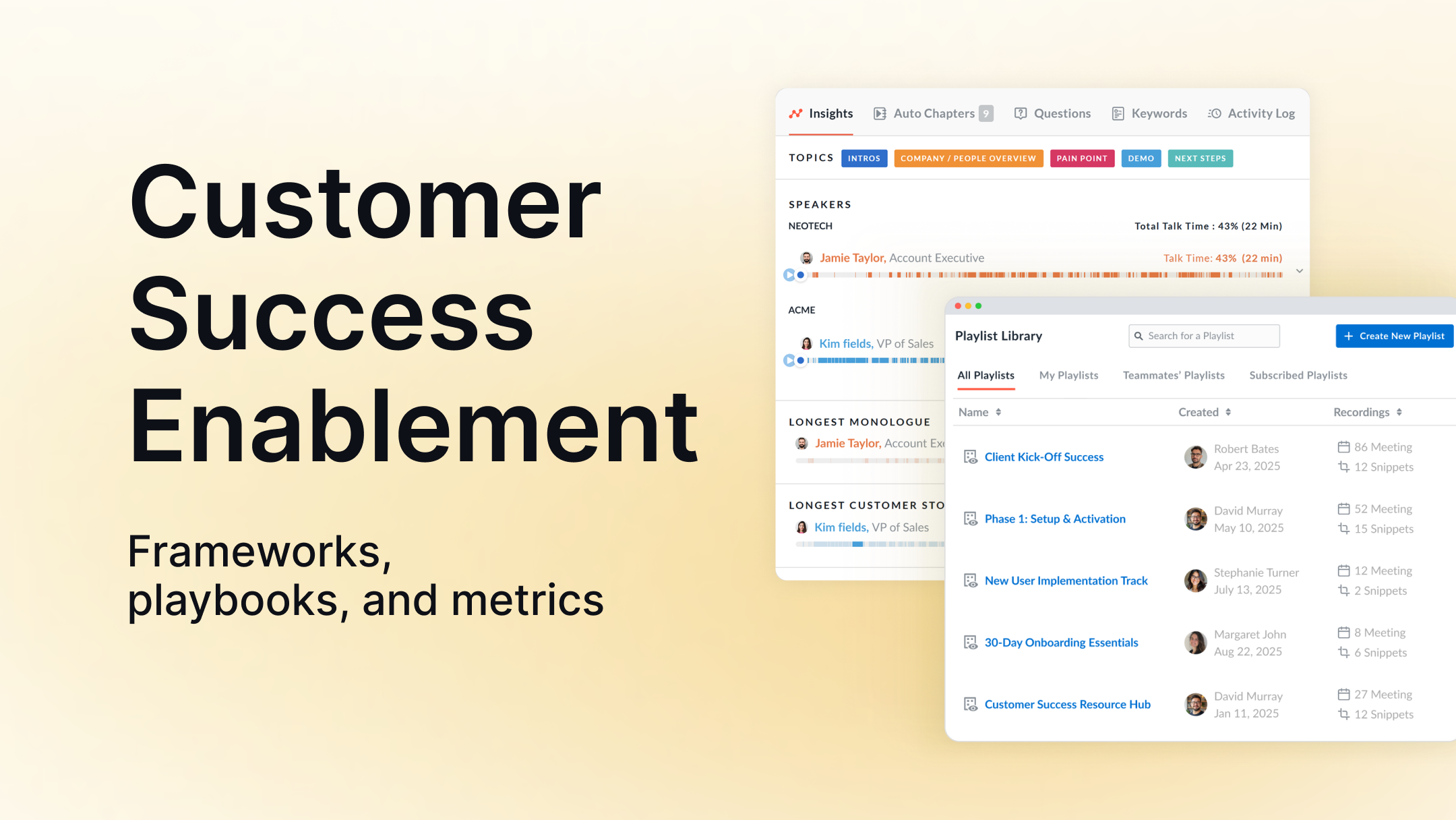Sales follow-up guide: Cadence, channels, and messages that convert
Table of Contents:

Avoma’s deal-won report from the last six months shows something every sales leader feels instinctively: sales follow-up is a major differentiator.
In fact, 40% of all closed-won deals credited follow-up as one of the key reasons for the win. Post-demo recaps, trial check-ins, scheduling follow-ups, contract nudges, and momentum-keeping touches consistently showed up in the summaries (see the infographic below for the exact breakdown).
Buyers move fast, get distracted, and juggle competing priorities. If you don’t stay present with clear, value-driven follow-ups, even a great conversation loses steam.
This guide breaks down exactly how to do that: the timing, cadence, channels, and sales follow-up emails that consistently win replies and move deals forward.
The data also reveals five follow-up patterns that consistently appear in closed-won deals: post-demo recaps, trial management follow-ups, technical and onboarding support, scheduling follow-ups, and contract nudges.
TLDR
- Silence usually means the buyer is busy or distracted, not that they’re uninterested.
- Top reps win because they follow up, add value, and guide clear next steps.
- Effective sales follow-up emails are timely, specific, and tied to a clear next step.
- Avoid generic messages, vague timing, and follow-ups with no purpose.
- Use a simple cadence: follow-up within 24 hours, again in 2–3 days, and run 6–8 touches over 2–3 weeks.
- Make every follow-up personal, relevant, and easy to respond to.
- Use specific templates for demos, proposals, no response, value drops, and breakups.
- Tools like Avoma automatically draft follow-ups, extract action items, and alert you to risks and opportunities.
- Consistent follow-up wins deals. Pick one active opportunity and tighten your cadence today.
Why does sales follow-up matter (and why do most reps get it wrong)?
Sales follow-up matters because buyers need reminders, context, and value before they make a decision. Silence is not rejection. Silence usually means the buyer is busy, distracted, or pulled into something more urgent.
Most deals are still winnable if you stay present with thoughtful, value-driven follow-ups.
And the data backs up what sales leaders already feel: in Avoma’s deal-won analysis from the last six months, follow-up showed up as one of the key reasons in 40% of closed-won deals. The infographic below breaks down exactly which follow-up moments (post-demo recaps, trial check-ins, scheduling nudges, contract push-throughs, and momentum-keeping touches) most often contribute to wins.
Most deals are still winnable if you stay present with thoughtful, value-driven follow-ups.
Why follow-up matters
- Buyers forget. You help them refocus.
- Buyers compare vendors. You stand out by staying consistent.
- Buyers hesitate. You reduce risk with clarity and value.

Why most reps get it wrong
Most reps break deals in one of three ways:
1. They use generic messages: Lines like "Just checking in" or "Any updates" add no value and create mental work for the buyer. Busy buyers ignore vague messages.
2. They follow up at the wrong time: Some follow up too soon and sound pushy. Others wait too long and lose the window of relevance.
3. They forget the purpose of the follow-up: A follow-up is not a poke. It is a continuation of the sales conversation. It must remind the buyer of their problem, reinforce the value, or make the next step easier.
Follow-ups that remove friction win more deals. In Avoma’s win summaries, buyers consistently responded when reps made their next step easier by sending recap notes so they didn’t have to dig through meetings, sharing recordings for stakeholders who missed the call, answering security or pricing questions before they were asked, or providing the exact document needed to move procurement forward.
When your follow-up lifts the burden off the buyer, momentum improves and the deal moves faster.
The three pillars of an effective sales follow-up strategy
Effective follow-up is not guesswork. It sits on three pillars that top reps use every day: timing, channels, and message strategy. When these three align, buyers reply faster and deals move forward with less friction.
Pillar 1: Get your timing and cadence right
Follow-up timing matters because buyers respond when the message arrives close to the moment they care about the problem you solve.
Here is the timing that works in real sales cycles:
- Follow up within 24 hours after any meeting or demo.
- Follow up again 2 to 3 days later if you get no response.
- Send 6 to 8 touches over the next 2 to 3 weeks.
- Slow the cadence after you’ve shared a meaningful value drop, not just because they haven’t replied yet.
- Speed it up when the buyer shows intent, engagement, or urgency.
Buyers take action when you stay present without being intrusive. When your sales follow-up emails hit at the right time, buyers are far more likely to respond and move to the next step.
Pillar 2: Use a multi-channel approach
Follow-up is more effective when you show up across the channels buyers already use. Email alone is too easy to ignore. Calls alone feel intrusive. The right mix creates visibility without pressure.
The channels that work best together:
- Email: Your primary follow-up tool. Use it for detail, clarity, and value.
- Phone or voicemail: Use this when you need urgency or want to break long silence.
- LinkedIn: Ideal for light touches, credibility, and staying top of mind.
- SMS: Use sparingly for confirmations or post-meeting nudges.
- Video message: High-impact for proposals or late-stage deals.
A multi-channel strategy increases your chances of reaching the buyers at the right moment.
Pillar 3: Add value, personalize, and always lead to the next step
A strong follow-up message does three things: it reminds the buyer of what matters, connects to their specific situation, and gives them a clear next step.
Before you think about the structure of a message, remember this: responsiveness builds trust. Avoma’s win summaries repeatedly mentioned words like prompt, immediate, within hours, and kept momentum. Speed signals reliability, and reliability wins deals.
A winning follow-up includes:
- A quick reminder of the problem or goal they shared
- One piece of value they can use right now
- Personalization tied to their company, role, or pain
- A simple, low-friction call to action
When your message is relevant, buyers respond. When it adds value, they trust you. When it’s clear, they act. Top reps understand this, which is why they never send empty follow-ups; every touch earns its place in the buyer’s inbox. They treat every sales follow-up email as a chance to add clarity, reduce friction, and reinforce value.
How to write a sales follow-up email (framework + templates)
Great follow-ups are simple, relevant, and easy to respond to. Use these templates as a starting point, then personalize based on your notes and the buyer's context.
1. Follow-up after an initial meeting or demo
Avoma’s deal-won analysis reveals post-demo follow-ups as the most common reason deals move forward. These recap-style emails reduce buyer friction and keep the evaluation on track.
Subject: Next step from our conversation today
Hi [Name],
Good speaking with you today. I pulled together the quick summary of what you shared:
[Pain point 1][Pain point 2][Goal they want to hit]
Based on that, the step that will move things forward is [proposed next step].
Does [day/time option] work for you?
Happy to adjust if needed.
Why this works:
It shows you listened, reduces mental load for the buyer, and gives them a clear next step.
2. Follow-up after sending a proposal or pricing
Contract-stage follow-ups were another major theme in won deals.
Subject: Quick clarification before you review
Hi [Name],
Sharing one quick detail that usually helps during review. Most teams use [specific feature or option] to solve [specific use case they mentioned]. It ultimately reduces the ramp time by [metric, benefit].
If helpful, I can walk you through the tradeoffs so you can pick the best option for your team.
Does [day/time] work?
Why this works:
It adds value instead of pressuring them, and positions you as a guide during their internal evaluation.
3. Follow up when you get no response after a few days
Subject: Quick check-in on [project/goal]
Hi [Name],
Checking in because I want to make sure I did not miss anything on your side.
If priorities shifted, no problem. If you still want to explore [goal or outcome], I can help you move this forward quickly.
Which of these is accurate?
Still interestedTiming is offNot a fit right now
Just reply with the number. Easy on your end.
Why this works:
It reduces friction by providing an easy, one-click response and respects their time.
4. Follow-up with a value drop
Subject: Thought this might help your team
Hi [Name],
Saw this resource and thought of your team since you mentioned [specific pain].
Here it is: [link, case study, playbook, insight]
If you want, I can walk you through how teams similar to yours used this to fix [pain] in under [timeframe].
Want to take 10 minutes this week?
Why this works:
You earn attention by giving value without asking for anything first.
5. Multi-threading a deal (reaching another stakeholder)
Multi-threading is one of the strongest patterns in Avoma’s deal-won analysis of closed-won deals. Many wins highlighted how reps kept momentum by engaging multiple stakeholders early and sharing clear follow-ups across the account.
Deals slow down when only one contact is driving the evaluation. Multi-threaded follow-ups prevent this by keeping everyone aligned.
The most effective multi-threading follow-ups included:
- Sending recap emails to stakeholders who missed the meeting
- Sharing call recordings for quick internal review
- Looping in leadership with a concise value summary
- Coordinating with procurement, IT, or security as soon as they appear
- Copying relevant teammates on next-step updates
Our data showed that deals with early multi-threading had fewer delays and a smoother path to close. A simple follow-up that brings a new stakeholder up to speed often removes weeks of friction.
When you follow up across the account, not just with one person, you create alignment, reduce risk, and help the entire buying group move forward together.
Multi-threading follow-up template
Subject: Quick context from our conversation with [Name]
Hi [Name],
I spoke with [primary stakeholder] earlier about [problem/goal they shared]. Sending you a quick recap since this likely connects to your priorities as well:
[Key pain or objective][Impact or urgency][Agreed next step or direction]
If helpful, I can walk you and [primary stakeholder] through how similar teams solved this and what a realistic timeline looks like.
Does [day/time option] work for a short sync?
Happy to adjust.
Why this works:
Short, direct, and easy for a new stakeholder to process. It gives context without overwhelming them and creates alignment across the account. This pattern emerged in our deal-won analysis: reps who pulled in additional stakeholders early, with clear follow-ups, advanced deals faster, and saw fewer delays.
6. Break up email (final attempt)
Subject: Should I keep this open?
Hi [Name],
I have not heard back, so I am pausing outreach for now. Before I close the file, I wanted to check one last time.
Should I:
Close this outfollow-up in a few weeksRestart if timing has opened up
Just reply with the number. No pressure either way.
Why this works:
It creates a low-pressure moment. Many buyers respond to avoid losing access or future help.
7. Post-sale follow-up
Subject: Quick check-in after your kickoff
Hi [Name],
Hope the team is settling in well. Checking in to make sure everything is on track with [product or rollout].
If anything needs attention, I can help you sort it out quickly.
Want a quick sync this week?
Why this works:
Shows proactive support, builds trust, and positions you for expansion or referrals.
How to build your repeatable follow-up system
A follow-up system works only when it removes guesswork for reps and creates a consistent rhythm across your pipeline. The goal is simple: never lose a deal because the follow-up was forgotten, rushed, or poorly written.
This is where structure, simple workflows, and the right tools matter.
Map your follow-ups to each stage of the pipeline
Start by making each stage predictable. When reps know exactly what the next touch should look like, deals stay in motion.
- New lead: Fast follow-up. Minutes or hours, not days.
- Discovery completed: follow-up recap plus next step within 24 hours.
- Proposal out: A planned sequence for the next 10 to 14 days.
- Late stage: Tight mix of email, call, and LinkedIn to keep momentum.
- Closed won: Post-sale check-ins to drive retention and upsell opportunities.
When the rules are clear, you eliminate hesitation and inconsistency.
Use your tools to automate the busy work, not the relationship
Automation should make follow-up easier, not replace the rep's judgment or tone. This is where Avoma fits naturally into a seller’s workflow.
After every meeting, reps can open the call in Avoma and click "Send follow-up email." Avoma drafts the email instantly using the notes and action items already captured during the call. The draft opens inside Avoma but sends through Gmail or Outlook, so reps stay in their normal workflow and still send from their own domain.
No tool switching. No formatting issues. No copy-paste hassles. Just an accurate follow-up ready in seconds.
Avoma also surfaces the next step at the deal level, so both reps and managers know exactly what needs to happen next. Whether it’s sending requested details, scheduling a deeper dive, or looping in a stakeholder, the next action is clear and visible.
Many won deals in our analysis referenced the impact of precise follow-up recaps. Reps using Avoma’s AI-generated notes sent cleaner summaries because the key points, action items, and decision drivers were already extracted for them. When your follow-up reflects exactly what the buyer said, trust increases and deals move faster.

Build simple sequences and personalize on top
Think 6 to 8 touches across email, call, and LinkedIn. Use two value drops and one break-up email.
When reps use Avoma, they already have:
- Action items AI extracted from the meeting
- Key moments flagged
- Recap notes ready to reference
This makes personalizing the first line of every follow-up easy. The context is already summarized.
Use action items to drive internal and external follow-ups
Action items are often the real trigger for next steps.
Avoma automatically extracts them from the call transcript, timestamps them, and lists them in the meeting summary.
Reps use these to:
- Draft accurate follow-up emails
- Update CRM fields in Salesforce or HubSpot
- Create internal tasks for product, onboarding, or leadership
- Trigger alerts or reminders for themselves or their managers
- Keep deals aligned across multiple stakeholders

When action items flow directly into the CRM, nothing slips through the cracks.
Use alerts to stay ahead of risks and opportunities
Alerts help you stay proactive instead of relying on guesswork. With Avoma, you can set alerts for things like:
- Competitor mentions
- Objections
- Budget or timing concerns
- Phrases like "I'll get back to you"
- Technical blockers or integration questions
- Custom keywords tied to your deal stage
Alerts can go to Slack or email, and can be private or shared with the team. You choose whether they fire instantly, daily, or weekly.
Why this matters:
Our deal-won analysis showed that timely follow-ups after risk signals played a major role in closed-won outcomes. Reps who jumped in quickly when a buyer mentioned a competitor, raised an objection, or hit an internal blocker often saved the deal.
Alerts surface these moments automatically so you can follow up while the concern is fresh, not after it becomes a deal stopper.
Alerts also capture positive momentum, such as:
- Action items completed
- Trial usage patterns
- Questions from new stakeholders
- Movement across deal stages
When you see the right signals at the right time, your follow-up becomes targeted, timely, and far more effective.
The infographic above breaks down five follow-up patterns that repeatedly showed up in Avoma’s win–loss analysis and directly influenced closed-won outcomes.
Use win–loss insights to strengthen your follow-up system
When deal risk alerts go unnoticed, which is rare, and a deal is lost because of weak or missing follow-up, Avoma’s win–loss analysis shows exactly where things slipped. It highlights the specific gaps that caused the deal to stall, such as:
- Missed next steps
- Delayed responses
- follow-ups that lacked clarity or value
- No follow-up after a key signal or blocker
These insights help managers understand the real reasons behind stalled or lost deals and spot behavior patterns that need improvement.
With this visibility, managers can coach reps earlier, reinforce what effective follow-up looks like, and build a more consistent follow-up rhythm across the entire team.
Track the metrics that actually matter
A follow-up system improves when you track real buyer intent signals.
- Reply rate shows if your message resonates.
- Time to first touch shows discipline.
- Touches per deal shows deal health.
- Channel performance shows where buyers respond.
- Proposal to close rate shows follow-up quality.
With tools like Avoma feeding action items, alerts, and summaries into the CRM, these metrics become easier to understand and coach around.
Keep the system simple so reps actually use it
The strongest follow-up system is the one reps stick to.
Keep it structured, repeatable, and supported by tools that handle the heavy lifting.
When follow-up emails write themselves, action items sync automatically, and alerts surface the moments that matter, reps can focus on the part humans do best: having real conversations that move deals forward.
Where sales follow-ups break down, and how to get them right
Follow-up problems show up in almost every sales cycle. The reps who win are the ones who recognize these patterns early and fix them before the deal slips. Here are the most common challenges and how to handle them.
Silence after a demo
Buyers go quiet for two reasons: they got pulled into something else or they are unsure about the next step.
Fix it by sending a simple recap with action items and a suggested time. Make the decision easy for them.
If you use Avoma, this becomes faster because your recap and action items are already captured. One click generates the follow-up draft, so you stay consistent even when your schedule is packed.
Long sales cycles with multiple stakeholders
Deals with multiple buyers slow down fast. One person is ready. Another is waiting. A third is unaware of the value.
Fix it by multi threading early. Reach out to secondary stakeholders with context. Keep each thread aligned with clear next steps.
Use alerts for phrases like "Loop in our leadership" or "Let me check internally" so you know when a stakeholder shift is happening.
Prospects saying "not now" or "circle back later"
Timing objections are normal. The mistake reps make is going dark until the next quarter.
Fix it with a light, long-term follow-up sequence. Share value drops. Stay relevant without pressure.
Action items and alerts keep you aware of internal shifts, so you follow up at the right moment.
How do you handle ghosting without sounding desperate?
Trying too hard kills deals. Ghosting happens because the buyer is overloaded, not because they dislike you.
Fix it by switching to low-friction follow-ups. Offer options. Use a numbered reply email. Add small pieces of value.
Time zone issues in global selling
APAC, EMEA, and US buyers operate on different timelines. A follow-up at the wrong time gets buried.
Fix it by adjusting send times based on the region.
Auto-drafted follow-ups help you respond even when the buyer ends a meeting late in their day.
Reps forgetting next steps
In fast moving pipelines, context slips. A rep forgets a key takeaway or loses a next step in the middle of a busy day. That leads to sloppy or delayed follow-ups.
Fix it by relying on captured action items, summaries, and alerts.
When every meeting has automatically extracted action items and next steps, reps cannot miss what matters. Follow-ups stay sharp and accurate, even under pressure.
The real fix: consistency
Most follow-up challenges are rooted in inconsistency. It is rarely a timing issue, a template issue, or a tooling issue. Reps succeed when they follow up with clarity, relevance, and predictable rhythm.
A simple, well defined system supported by the right tools helps every rep stay on track. When action items are captured automatically, follow-up drafts are ready right after the meeting, and alerts surface the moments that need attention, deals stop slipping through the cracks.
Avoma also helps teams understand why deals were lost by capturing detailed lost reasons. You might see that a rep relied only on scheduling prompts without adding new insights or tailored value, which led the prospect to deprioritize the evaluation. These insights give managers better coaching opportunities and help reps refine their follow-up approach for future cycles.
Conclusion
Follow-up is one of the most reliable ways to keep deals moving, yet it is where many reps lose momentum.
A strong follow-up reminds the buyer what they want to achieve, reinforces how you can help, and makes the next step easy. When your action items are captured automatically and your follow-up drafts are ready right after the meeting, staying consistent stops being a chore and becomes part of your rhythm.
Pick one deal in your pipeline and send a clear, value-driven follow-up today. Consistent follow-up wins deals.
The follow-up patterns in the infographic above reinforce the same theme: consistent, value-driven follow-up is one of the biggest behavioral differences in closed-won deals.
If you want to see how Avoma simplifies the most challenging aspects of follow-up: drafting emails, capturing action items, surfacing risks, and reminding you exactly when to re-engage.
Start a free trial or book a quick demo.
See how fast deals move when follow-up becomes effortless.
Frequently Asked Questions
A sales follow-up is the communication you send after an initial interaction with a prospect. It reinforces their goals, answers questions, and guides them toward the next step. Strong follow-up keeps deals from going cold.
Write a clear and concise sales follow-up email that references your last conversation, adds value, and ends with a simple next step. Avoid vague phrases like "Just checking in" because they provide no context and get ignored.
Send your first follow-up within 24 hours. If there's no response, follow-up again in 2 to 3 days. Most deals need 6 to 8 touches over 2 to 3 weeks, so timing and consistency matter.
A complete follow-up sequence usually includes 6 to 8 touches across email, calls, and LinkedIn. Buyers often respond only after multiple touches, so stopping early costs pipeline.
Summarize what the buyer cared about, restate the value they would get, and propose a clear next step. This shows you listened and makes it easy for them to decide.
Use subject lines that reference context or value, like "Next step from our conversation" or "Quick follow-up on your goals." Clear subject lines get higher open rates.
Focus on value, not pressure. Share a resource, answer a question they raised, or offer options for next steps. Make responding easy and remove friction.
Silence usually means the buyer is busy or working through internal steps. It rarely means the deal is dead. A clear, timely follow-up brings the conversation back into focus.
Use tools like Avoma that auto-draft follow-up emails based on meeting notes and action items. Automate reminders and tasks, but personalize your message so it still feels human.
Use a mix of email, calls, LinkedIn, SMS, and occasional video. Buyers respond differently across channels, and a multi channel approach increases your chances of getting a reply.






What's stopping you from turning every conversation into actionable insights?









